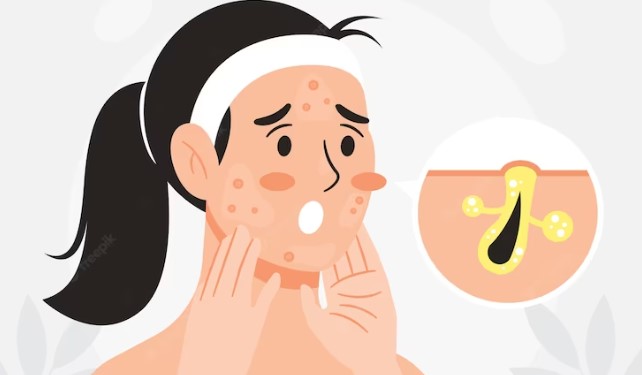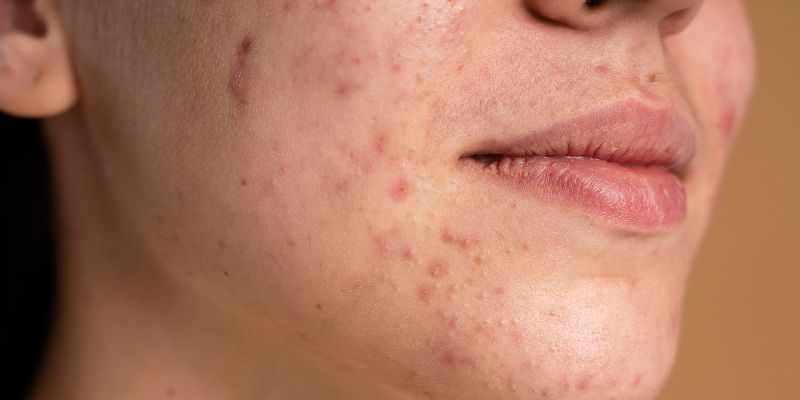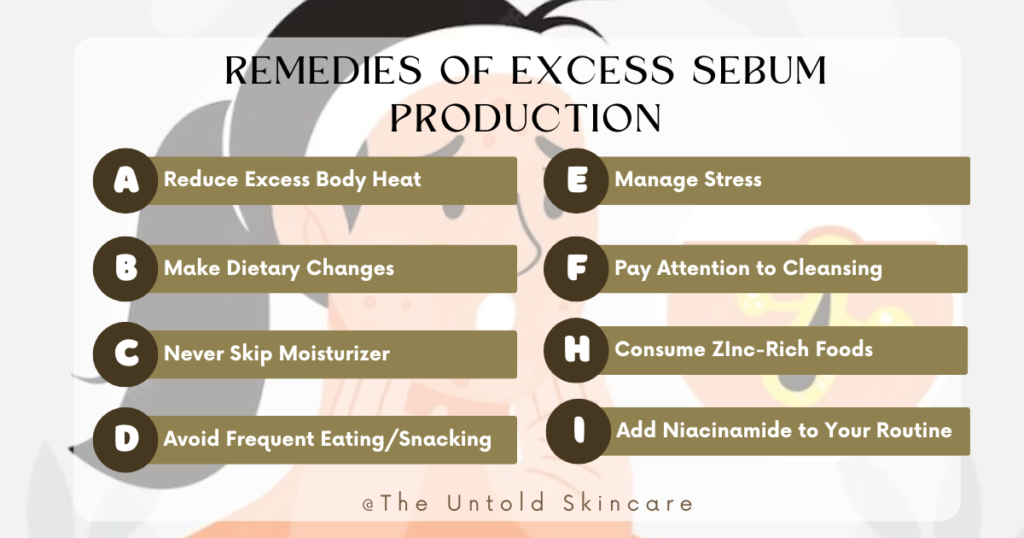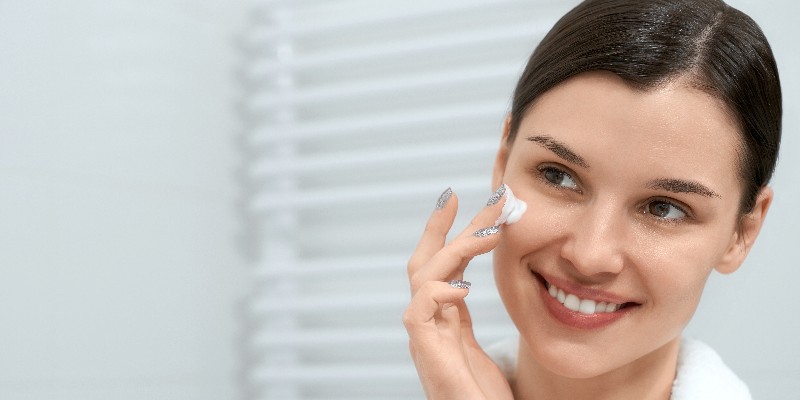Are you dealing with excessively oily skin on your face? If so, you’re not alone!
In the eternal quest for glowing and flawless skin, managing sebum production plays a pivotal role.
Excessive sebum production is a common problem for many people, and it can cause a variety of issues like enlarged pores, frequent breakouts, greasy skin, and many more.
Fortunately, there are several steps you can take to reduce sebum production and maintain distance from those kinds of skin issues.
In this article, we’ll share everything you need to know to master the battle against excessive sebum production. So, whether you have naturally oily skin or are experiencing a temporary increase in oil production, keep reading to learn how to reclaim control of your skin and keep your skin looking and feeling its best.
What is Sebum? Let’s Start With That

Before we dive into the nitty-gritty of sebum control, let’s understand what really sebum is.
Sebum is an oily substance produced by the sebaceous glands, located beneath the skin’s surface. It is a complex mixture of lipids (fats) that basically consists of triglycerides (about 57%), wax esters (about 26%), free fatty acids, and squalene.
The composition of sebum can vary among individuals and can be influenced by factors such as genetics, age, and hormonal changes. Its primary function is to keep our skin moisturized and create a protective barrier against external elements.
How is it Produced?
Sebum is produced in the skin through a process called sebumogenesis. Sebaceous glands are responsible for secreting sebum. These tiny glands are scattered throughout our skin, with a higher concentration on the face, scalp, and chest.
The sebaceous glands, which are located within the skin, take in fatty acids and cholesterol from the bloodstream. These components are then processed within the sebaceous glands to create sebum.
This produced sebum is stored in the sebaceous gland until it is ready to be released. It is released onto the skin’s surface through the hair follicles. It travels up the follicle and is spread across the skin’s surface.
What Sebum Does and Why is it Important For Our Skin?
One of the primary roles of sebum is to keep our skin moisturized and hydrated. It acts as a natural lubricant, preventing excessive dryness and maintaining the skin’s elasticity.
Sebum forms a protective barrier on the surface of the skin, preventing moisture loss and shielding it from external factors such as pollutants and harsh weather conditions.
Furthermore, sebum contributes to the natural pH balance of our skin. It helps to create an acidic environment that acts as a defense mechanism against harmful bacteria, fungi, and other pathogens.
This acidic pH is essential for maintaining the skin’s microbiome, a delicate ecosystem of microorganisms that play a vital role in protecting against infections and keeping the skin healthy.
Sebum also helps to transport important nutrients to the surface of the skin. It carries essential fatty acids, vitamins, and antioxidants that are necessary for maintaining optimal skin health. These nutrients help to nourish and repair the skin, promoting a youthful and radiant complexion.
What Are The Causes of Excess Sebum Production?
Excess Body Heat
Excess body heat is one of the least talked aspects of skincare but it is one of the major culprits behind your oily and greasy skin.
If you have the problem of excess body heat, the body’s natural mechanism to cool your body down over-activates the sweat and sebaceous glands. This over-activated sebaceous gland is responsible for producing excess sebum production.
Excess body heat also dilates (widen) the blood vessels near the skin’s surface to dissipate heat. This increased blood flow can stimulate the sebaceous glands to produce more sebum.
Additionally, when the skin is subjected to excess body heat, it can trigger an inflammatory response. Inflammation can stimulate the sebaceous glands to increase sebum production.
Overwashing The Skin
When you wash your face frequently or with harsh cleansers, you can strip away the natural oils (sebum) that your skin produces to maintain its barrier function.
This can compromise the skin’s protective barrier. When this barrier is disrupted, the skin may respond by producing more sebum in an attempt to compensate for the loss of moisture and protection.
Also, when the skin is excessively stripped of its natural oils, it can respond by producing even more sebum to try to restore balance. This can lead to an overproduction of sebum, making the skin feel oilier than before.
Genetics
Genetics can play a significant role in determining sebum production.
The size and activity of your sebaceous (oil) glands are determined, in part, by your genetics. Some individuals may inherit larger or more active sebaceous glands, which produce and release more sebum onto the skin’s surface. This genetic predisposition can result in naturally oily skin.
Genetic variations can also affect the number and sensitivity of hormonal receptors in the skin. Androgens, such as testosterone, play a key role in regulating sebum production. Genetic factors can influence how your skin responds to these hormones, leading to increased sebum production.
Hormonal Issues
One of the primary factors contributing to excessive sebum production is hormonal imbalances.
During puberty, hormonal fluctuations can trigger an increase in sebum production, leading to acne breakouts and greasy skin. Similarly, hormonal changes during the menstrual cycle, pregnancy, or menopause can also influence sebum production levels.
Diet
Foods with a high glycemic index, such as sugary and processed carbohydrates, can lead to rapid spikes in blood sugar levels. This, in turn, may trigger the release of insulin which can influence sebum production.
Some studies suggest that consuming a diet high in unhealthy fat can lead to increased sebum production. Also, dairy products have been associated with increased sebum production in some individuals.
Similarly, deficiencies in certain vitamins and minerals, such as zinc, can affect skin health and sebum production. Adequate intake of these nutrients is essential for maintaining a balanced sebum production process.
Certain Medications
Some birth control pills contain hormones that can affect androgen levels in the body which can stimulate sebaceous glands and increase sebum production.
Medications like oral corticosteroids, used to treat various inflammatory conditions, can affect hormone levels in the body. Prolonged use of systemic corticosteroids can lead to increased sebum production and acne breakouts.
Chronic Stress
Stress can increase sebum production, and this is primarily due to the complex interplay between the nervous system, endocrine system, and skin.
Stress triggers the release of stress hormones, primarily cortisol, from the adrenal glands. Stress hormones like cortisol can stimulate the sebaceous glands to produce more sebum.
Stress also triggers an inflammatory response in the body which can further magnify the issue.
Bad Skincare Routines/Products
A bad skincare routine or the use of inappropriate skincare products can potentially contribute to increased sebum production and skin-related issues
Factors such as over-washing, using harsh products, scrubbing, over-exfoliation, product sensitivity, use of comedogenic products, etc. associated with a bad skincare routine can also increase sebum production.
What Are The Signs of Excessive Sebum Production?
Excessive sebum production can manifest in various signs and symptoms. The most obvious sign is an overall greasy or shiny appearance of the skin, particularly in the T-zone (forehead, nose, and chin) but can occur on other parts of the face and body parts like chest and upper back.
Also, excess sebum can cause pores to appear larger and more noticeable.
Excessive sebum production can extend to the scalp, leading to an oily or greasy scalp. This can make your scalp itchy and can also cause dandruff-related issues.
Some individuals with oily skin may also experience skin sensitivity or redness, especially after washing the face or while applying skincare products.
What Are The Effects of Excessive Sebum Production?

One major effect of excessive sebum production is the development of acne. When excess sebum combines with dead skin cells and bacteria, it can clog your pores, leading to the formation of pimples, blackheads, and whiteheads. These blemishes can be painful and inflamed, and leave behind scars or dark spots, further affecting the appearance and texture of your skin.
Excessive sebum production can also lead to an uneven skin tone and texture. The buildup of oil and impurities can cause your skin to appear rough and bumpy.
Additionally, the constant presence of oil on the surface of your skin can prevent proper exfoliation, resulting in a dull complexion and an overall lackluster appearance.
The excess oil on the skin can also create a favorable environment for the growth of fungi, such as Malassezia, which can lead to fungal skin infections. It also increases skin inflammation exacerbating conditions like rosacea or eczema.
Related Topic: Dermatologist-Recommended Skincare Products for Oily Skin
How to Reduce Sebum Production?
Now let’s put an end to all those negative talks and start discussing why you are actually here.
There are several remedies that can help control the excessive sebum production. If you follow them on a regular basis, you can actually get rid of that oily and greasy skin. So, let’s start.

Reduce Excess Body Heat
My first-place cause of excessive sebum production was the extra body heat, and my first-place remedy for sebum production is to lower that same body heat.
Drinking coconut water daily is an extremely effective way of reducing excess body heat. It naturally has cooling properties that is quite helpful in keeping the body calm and hydrated.
Cold Foot Bath is another tried and tested method to reduce body heat. The cold water can absorb excess body heat helping in keeping the body temperature down. Just dip your foot in cold water every day for about 10 minutes before going to bed. This is something that I highly recommend based on my own experience.
Similarly, using clay pots to store drinking water can also help reduce body heat. The small microscopic pores present in the clay pot naturally cool down the water through air circulation. Some studies have also shown that drinking water from clay pots also increases metabolism, thus producing lesser heat during the process.
Also Read: How Excess Body Heat Damages Your Skin and What Are The remedies?
Make Dietary Changes

High-glycemic foods like sugary snacks and processed carbohydrates are linked to increased sebum production. They cause rapid spikes in blood sugar levels, thus elevating the body’s insulin level and triggering the release of androgen.
Limit your caffeine and alcohol intake as both of them can dehydrate the body, which may lead to increased oil production.
Dairy products can also trigger increased sebum production and acne. Consider reducing dairy from your diet. Also, avoid spicy foods as they can dilate blood vessels and potentially trigger sebum production
Never Skip Moisturizer

It is extremely crucial to keep the skin moisturized to reduce excessive sebum production.
When the skin lacks moisture, it can trigger a feedback loop where the body tries to compensate by producing more oil. When the skin is adequately moisturized, it sends signals to the sebaceous glands that there’s no need to produce excessive oil.
By keeping the skin moisturized with a moisturizer, you help prevent this cycle of moisture loss and oiliness.
Also, when the skin’s barrier function is compromised due to dryness, it can trigger a response where the sebaceous glands produce more oil to compensate for the lack of moisture. Using a moisturizer helps reinforce this barrier, reducing the need for your skin to overproduce sebum.
Avoid Frequent Eating/Snacking
Frequent eating can lead to chronically elevated insulin levels, which can disrupt hormone balance in the body. Insulin resistance, a condition where cells become less responsive to insulin, can develop with constant spikes in insulin levels.
Elevated insulin levels can stimulate the sebaceous glands to produce more sebum. This is why intermittent fasting is becoming quite popular in skincare these days. This involves limiting the hours during which they eat each day. Intermittent fasting can help regulate insulin sensitivity and promote more stable blood sugar levels, potentially reducing the likelihood of excessive sebum production.
Manage Stress

Chronic stress triggers a series of hormonal and physiological responses in the body, some of which can lead to increased oiliness and skin problems.
Chronic stress can lead to an increase in stress hormones, particularly cortisol. Elevated cortisol levels can stimulate the sebaceous glands to produce more sebum. By managing stress, you can help regulate cortisol levels, potentially reducing sebum production.
Stress can also promote inflammation throughout the body, thus exacerbating the condition of skin oiliness.
Start performing light exercises daily. Also consider breathing exercises and yoga as they can lower the effect of chronic stress. You can also take Ashwagandha powder as it is scientifically proven to contain stress-relieving properties.
Pay Attention to Cleansing
Cleansing itself is not a proven factor that can help reduce sebum production. But the way you cleanse your face can be a contributing factor.
Always choose a gentle, sulfate-free cleanser that is labelled as “oil-free” or “non-comedogenic”.
Avoid hot water while cleansing, as it can strip your skin of natural oils and potentially lead to increased sebum production.
Also, resist the temptation to over-cleanse your face, as this also can strip your skin of natural oils leading to increased oil production. Cleansing twice a day, in the morning and before bedtime, for about 30 seconds is usually sufficient.
Consume Zinc-Rich Foods

Zinc is involved in the regulation of the body’s androgen hormones, including testosterone. Androgens can stimulate the sebaceous glands to produce sebum (skin oil). Adequate zinc levels may help modulate androgen activity and, in turn, reduce the overproduction of sebum.
To incorporate more zinc-rich foods into your diet, consider foods such as lean meat, seafood, legumes, nuts and seeds, and whole grains such as quinoa.
Add Niacinamide to Your Skincare Routine
Several studies have backed niacinamide as an extremely potent ingredient in regulating sebum production.
The anti-inflammatory property of niacinamide can significantly help in keeping the sebaceous gland less active resulting in lesser sebum production.
To incorporate niacinamide into your skincare routine, you can use products like serums, moisturizers, or creams that contain this ingredient. It’s typically well-tolerated by most skin types, including sensitive skin.
Related Topic: Dermatologist-Recommended Skincare Products for Oily Skin
Also Read: 10 Much-Needed Lifestyle Changes For Clear Skin
Home Remedies to Reduce Sebum Production
Reducing sebum production by using home remedies can be a challenging task, as it is largely influenced by internal factors. However, there are some home remedies and practices that may help manage excess sebum:
Clay Masks

Clay masks can be beneficial for managing sebum production and controlling excess oil on the skin. They have natural absorbent properties that can draw excess oil (sebum) and impurities from the skin’s surface, helping to reduce shine and oiliness.
They can also penetrate pores and help to dislodge and remove debris, dead skin cells, and trapped sebum.
Fuller’s Earth is one of the most popular clay masks. You can mix it with other ingredients such as sandalwood powder, turmeric, and gram flour for extra benefits.
Tea Tree Oil
Among the numerous skin benefits of tea tree oil, helping to reduce sebum production is also one of them.
Its anti-inflammatory effect can help soothe irritated skin, thus reducing the trigger to your sebaceous gland.
Always dilute the tea tree oil with other carrier oil such as coconut oil or jojoba oil before using it.
Almonds and Honey
The mixture of almonds and honey can do wonders for reducing skin oiliness. The natural exfoliating properties of almonds and moisturizing properties of honey, when combined, can indirectly help to reduce the over-secretion of sebum.
Take 1 tsp of finely ground almonds and 1 tsp of honey. Mix them together to form a paste and apply it gently to your clean face. Leave it for 10 minutes and then rinse it off with warm water.
What Are The Foods That Help in Regulating Sebum Production?
Zinc-rich foods should be your top priority as discussed earlier.
Add more antioxidant-rich foods like berries, green tea, and dark leafy greens to your diet that can help reduce inflammation in the skin and potentially regulate sebum production.
Drink enough water daily as it can help reduce sebum production. When the skin is dehydrated, it may trigger an increase in oil (sebum) production as the body tries to compensate for the lack of moisture.
Also, Omega-3 fatty acids found in fatty fish (e.g., salmon, mackerel), flaxseeds, and walnuts have anti-inflammatory properties that may help minimize this skin issue.
Similarly, green tea and foods rich in selenium and vitamin A can also help regulate sebum production.
Blotting Paper/Oil-absorbing Sheets for Excessive Sebum Production
Blotting papers are designed to absorb excess oil from the skin, providing a quick solution to reduce shine and refresh your complexion.
They can temporarily reduce the appearance of excess oil on the skin’s surface, however, they do not address the underlying causes of excessive sebum production.
Also, they do not affect your skin, so there is no harm in using it. They are quite effective in absorbing excess oil from the skin, making it look fresh and less greasy.
So, you can use it as a temporary remedy as it can make you feel more confident about your skin.
Best Skincare Ingredients to Use For Excessive Sebum Production
Niacinamide is one of the top skincare ingredients that can help regulate sebum production.
Another ingredient that can help reduce sebum production is Salicylic acid. This beta-hydroxy acid (BHA) is excellent for oily skin. It penetrates oil-filled pores, exfoliates dead skin cells, and helps regulate sebum production. It’s particularly effective for treating and preventing acne.
Hyaluronic acid can also benefit people with oily skin. It helps maintain the skin’s moisture balance, which can indirectly reduce excess sebum production by preventing the skin from overcompensating for dryness.
Related Topic: Dermatologist-Recommended Skincare Products for Oily Skin
Frequently Asked Questions
1. How to reduce sebum production internally?
To reduce sebum production internally, you need to focus more on your lifestyle, your diet, and your hormonal balance. All of the solutions listed above precisely accomplish that. Therefore, give these treatments a try and include them in your daily routine. You will undoubtedly start to see effects in 1-2 weeks.
2. How to reduce sebum production on scalp?
The solution of sebum production is same for both face and scalp since the root causes of both issue are the same. So, all the remedies explained above are equally effective for both face and scalp.
3. How hormones affect sebum production?
Hormones affect sebum production by binding to receptors on the sebaceous glands in the skin. When hormones like androgens bind to these receptors, it stimulates the glands to produce more sebum. In individuals with high levels of androgens or increased sensitivity of sebaceous glands to androgens, sebum production can be excessive.
4. What are the mistakes in skincare that can cause excessive sebum production?
Some mistakes in skincare that can cause excessive sebum production are overwashing, using hot water, skipping moisturizer, and over-exfoliating.





